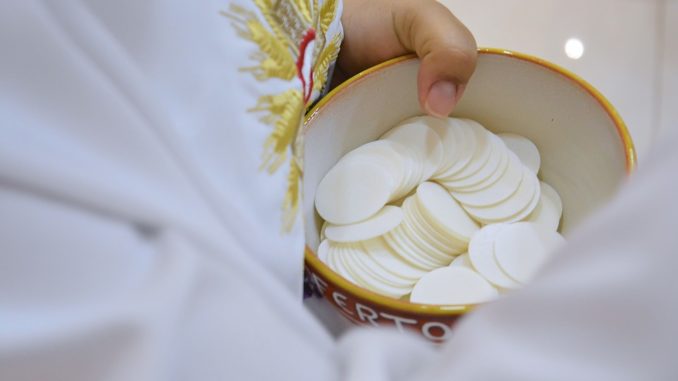Why do Catholics only receive the host in communion?

When Christians of Protestant denominations attend a Catholic mass, they are often surprised that Catholics receive only the consecrated host (the body of Christ represented by the wafer or edible bread), even when the consecrated wine (the blood of Christ) is consumed during part of the holy communion of the mass. In Protestant Christian churches, it is normal for the congregation to receive both wafers and wine as symbols of the holy blood and body of Christ.
An extreme example occurred during the visit of Pope Benedict XVI to the United States in 2008, when 100.000 Catholics received Holy Communion during the television masses at Washington Nationals Stadium and Yankee Stadium. Those who observed those masses saw the entire congregation receive only the consecrated host. In fact, while the wine was consecrated in those masses (as in every mass), only Pope Benedict, those priests and bishops who celebrated the masses and a small number of priests who acted as deacons received the consecrated wine.
Catholic views on consecration
While this state of affairs may surprise Protestants, it reflects the understanding of the Eucharist of the Catholic Church. The Church teaches that bread and wine become the Body and Blood of Christ at consecration and that Christ is present "body and blood, soul and divinity" in both articles. As the Catechism of the Catholic Church observes:
Since Christ is sacramentally present under each of the species, communion under the single species of bread makes it possible to receive all the fruit of Eucharistic grace. For pastoral reasons, this way of receiving communion has been legitimately established as the most common form in the Latin rite.
The "pastoral reasons" to which the Catechism refers include the easy distribution of Holy Communion, especially to large congregations, and the protection of the Precious Blood from being desecrated. Hosts can be eliminated, but they can be easily recovered; however, consecrated wine is more easily poured and cannot be easily recovered.
However, the Catechism continues in the same paragraph that:
"... the sign of communion is more complete if given in both types, since in that form the sign of the Eucharistic meal appears more clearly". This is the usual form of receiving communion in Eastern rites.
Eastern Catholic practices
In the Eastern rites of the Catholic Church (as well as in Eastern Orthodoxy), the Body of Christ in the form of consecrated cubes of a loaf of leavened bread is immersed in the Blood, and both are served to the faithful on a golden spoon. This minimizes the danger of spilling the Precious Blood (which is widely absorbed in the Guest). Since Vatican II, a similar practice has been revived in the West: the intention, in which the host is immersed in the chalice before being given to the communicator.
Consecrated wine is optional
While many Catholics around the world, and probably most in the United States, receive only the host for Holy Communion, in the United States many churches benefit from a concession that allows the communicator to receive the host and therefore drink from the chalice. . When the consecrated wine is offered, the choice of whether to receive it is left to the individual communicator. Those who choose to receive only the host, however, do not deprive themselves of anything. As the Catechism observes, they still receive "body and blood, soul and divinity" of Christ when they receive only the host.